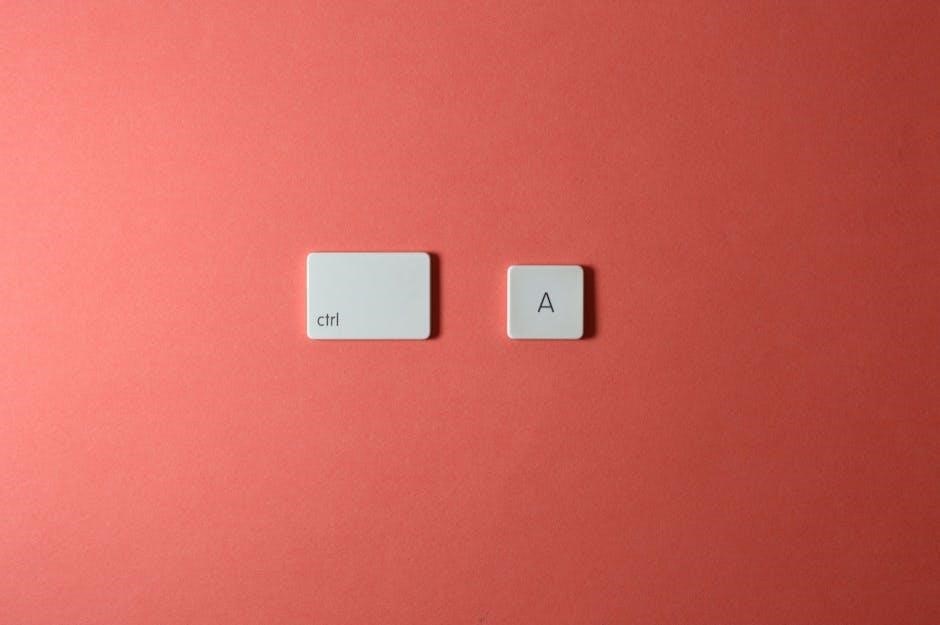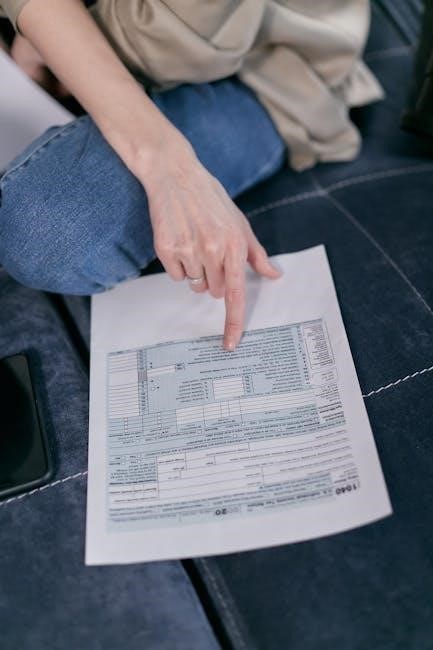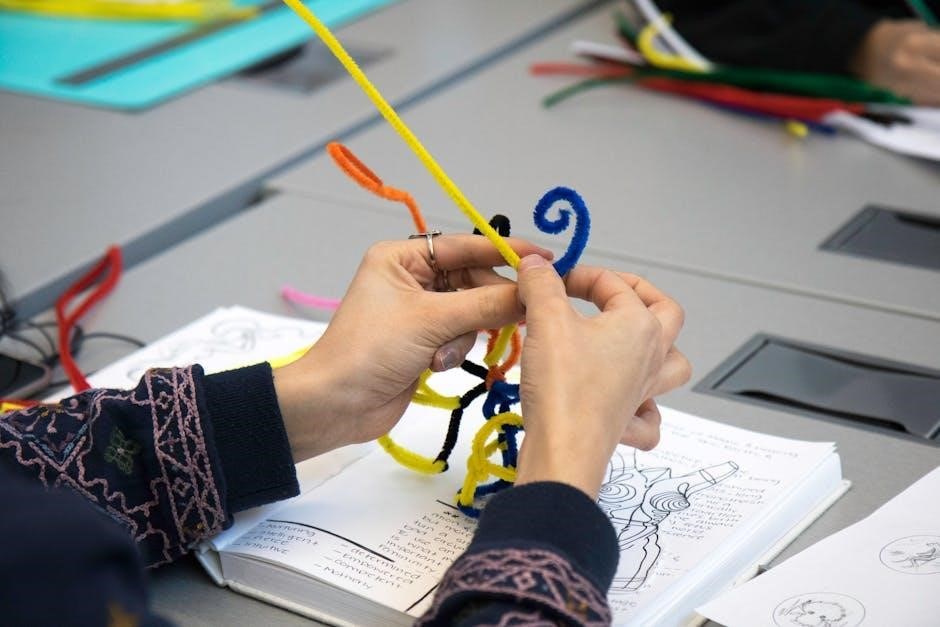
Welcome to the Wii U Instruction Manual‚ your comprehensive guide to setting up‚ operating‚ and troubleshooting the Nintendo Wii U console. This manual covers essential features‚ safety precautions‚ and detailed instructions to ensure smooth operation and enhance your gaming experience.
Overview of the Wii U Console
The Wii U is Nintendo’s eighth-generation console‚ combining innovative hardware with versatile gaming experiences. It features the Wii U GamePad‚ a tablet-like controller with a 6.2-inch touchscreen‚ offering both traditional and off-TV gameplay. The console supports HD graphics‚ backward compatibility with Wii games‚ and integrates with external devices. Designed for both casual and hardcore gamers‚ the Wii U emphasizes local multiplayer and media consumption. Its compact design and user-friendly interface make it a central hub for entertainment and gaming in any home setup.
Importance of Reading the Manual
Reading the Wii U instruction manual is essential for optimizing your gaming experience. It provides clear guidance on console setup‚ controller functionality‚ and safety precautions. Understanding the manual ensures proper use of features like the GamePad‚ HD graphics‚ and online connectivity. It also offers troubleshooting tips to resolve common issues quickly. By following the manual‚ you can maximize the console’s potential‚ enjoy seamless gameplay‚ and maintain system performance. It’s a comprehensive resource for both new and experienced users.
Preparation for Setup
Before setting up your Wii U‚ gather all necessary items‚ including the console‚ GamePad‚ AC adapters‚ and HDMI cable. Ensure your TV has an available HDMI port and a stable power source. Clear enough space for the console and controllers. Unpack all components carefully and verify no damage. Read the manual thoroughly to understand setup steps. Charge the GamePad and other controllers beforehand. Organize cables to maintain a tidy setup. Ensure your environment is ready for a smooth installation process. This preparation ensures a hassle-free experience.

Setting Up the Wii U Console
The Wii U setup involves connecting the console to your TV‚ syncing controllers‚ and configuring basic settings for a smooth gaming experience.
Unboxing and Physical Setup
Carefully unbox the Wii U console‚ GamePad‚ HDMI cable‚ power cord‚ and any additional accessories. Place the console on a flat‚ stable surface with proper ventilation. Connect the HDMI cable to your TV and the power cord to a nearby outlet. Insert batteries into the GamePad and ensure it is fully charged before use. Position the console and GamePad in a comfortable setup for gaming. Ensure all cables are securely connected to avoid loose connections during use.
Connecting to the Internet
Turn on the Wii U console and navigate to the System Settings from the Home Menu. Select “Internet” and then “Connect to the Internet.” Choose your network from the list of available options. Enter the network password using the on-screen keyboard. If prompted‚ download and install any available system updates. Ensure a stable connection is established for online features like the Nintendo eShop‚ multiplayer gaming‚ and system updates. A wired connection via Ethernet cable is also supported for reliability.
Initial Configuration and Updating
After connecting to the internet‚ proceed with the initial setup. Select your region‚ language‚ and time zone. Create a user profile or use an existing Nintendo Network ID for online features. Check for system updates in the System Settings menu. Updates improve performance‚ add features‚ and enhance security. Follow on-screen instructions to download and install updates. The console may restart during the process. Regular updates are essential for optimal functionality and accessing online services.

Using Wii U Controllers
The Wii U supports various controllers‚ including the GamePad‚ Wii Remote‚ and Pro Controller. Each offers unique gameplay experiences with motion controls and intuitive designs.
Wii U GamePad Functions
The Wii U GamePad features a 6.2-inch touchscreen‚ offering dual-screen gaming and off-TV play. It includes analog sticks‚ buttons‚ and motion controls for versatile gameplay. The GamePad also supports near-field communication (NFC) for amiibo functionality and serves as a remote for TV volume and channel control. Its battery life ranges from 3 to 5 hours‚ and it charges via USB or the Wii U charging dock. The GamePad enhances gameplay with intuitive touch and motion-based interactions.
Syncing the GamePad with the Console
To sync the Wii U GamePad‚ ensure the console is turned on and the sensor bar is plugged in. Navigate to the Wii U Menu‚ select “System Settings‚” and choose “Wii Remote & Sensor Bar” from the options. Turn on the Wii Remote or GamePad‚ and the console will automatically detect and sync the device. If syncing issues occur‚ restart the console and repeat the process. Proper syncing ensures optimal performance and control during gameplay.

Using Other Controllers (Wii Remote‚ Pro Controller)
The Wii U supports various controllers like the Wii Remote and Wii U Pro Controller for diverse gaming experiences. The Wii Remote offers motion controls‚ ideal for games requiring gesture inputs. Pair it by syncing it with the console via the sensor bar. The Pro Controller provides a traditional gaming feel with dual analog sticks and ergonomic design. Both controllers can be used interchangeably‚ depending on the game and user preference‚ enhancing gameplay versatility.

Navigating the Wii U Menu
The Wii U menu is designed for intuitive navigation‚ allowing users to easily browse apps‚ games‚ and settings. Use the GamePad to access and organize content‚ ensuring a seamless experience for all users.
Understanding the Home Menu
The Wii U Home Menu is the central hub for accessing games‚ apps‚ and system features. It displays recently played games and installed software‚ making it easy to navigate. Users can scroll through options using the GamePad or other controllers. The Home Menu also provides quick access to notifications‚ system settings‚ and user profiles. It is customizable‚ allowing users to organize their content for a personalized experience. This menu serves as the gateway to all Wii U functionalities.
Accessing System Settings
To access the Wii U System Settings‚ navigate to the Home Menu and select the “System Settings” icon. Use the GamePad or other controllers to scroll and select options. This menu allows you to adjust display settings‚ sound preferences‚ and system updates. Additionally‚ it provides access to parental controls‚ user account management‚ and storage options. System Settings is essential for customizing and maintaining your Wii U console to suit your preferences and ensure optimal performance.
Managing User Profiles
User profiles on the Wii U allow multiple players to save game progress and customize settings independently. To create or manage profiles‚ navigate to the System Settings from the Home Menu. Select “Users” to add‚ edit‚ or delete profiles. Each profile can have unique preferences‚ such as notification settings and digital game libraries. Parents can also link child profiles to apply parental controls. Profiles are essential for organizing gameplay and personalizing experiences for different users on the same console.

Playing Games on Wii U
The Wii U offers a variety of gaming experiences‚ including disc-based and digital titles. Players can enjoy multiplayer modes or use the GamePad creatively.
Inserting and Playing Game Discs
To play games using discs on the Wii U‚ insert the disc into the console with the label facing up. Ensure the console is powered on and the disc is properly seated. The game will automatically start once recognized. Handle discs carefully to avoid scratches. Always eject discs using the console’s controls to prevent damage. Never insert foreign objects or force discs into the drive. Keep discs clean and dry for optimal performance. Store games safely when not in use.
Downloading and Managing Digital Games
To download games‚ access the Nintendo eShop from the Wii U Menu. Browse or search for games‚ select the desired title‚ and choose “Download.” Ensure your console is connected to the internet and has sufficient storage space. Purchased games will automatically download and install. To manage digital games‚ organize them on the Home Menu or sort them into folders. Regularly check for game updates to ensure optimal performance. Digital games are tied to your Nintendo Network ID‚ allowing access across multiple consoles.
Using the GamePad for Off-TV Play
The Wii U GamePad enables Off-TV Play‚ allowing you to enjoy games independently of the television. To activate this feature‚ open a game and press the “Display” button on the GamePad. Ensure the GamePad is properly synced with the console and has sufficient battery life. Off-TV Play offers flexibility‚ letting you play in different rooms or when the TV is in use. The GamePad’s screen mirrors or complements the TV display‚ depending on the game.

Online Features and Connectivity
Explore online features like multiplayer gaming‚ digital downloads‚ and community interactions through the Nintendo Network‚ enhancing your Wii U experience with connectivity and convenience.
Nintendo eShop and Purchases
The Nintendo eShop offers a wide range of games‚ apps‚ and DLCs for purchase or download. Browse categories‚ search for titles‚ and read reviews to find your next favorite game. Purchases can be made using a credit card‚ Nintendo eShop gift cards‚ or funds added to your Nintendo Network ID. Downloads begin automatically once purchased‚ and you can monitor progress in the Download Manager. Ensure your console is connected to the internet and has sufficient storage before making purchases.
Online Multiplayer and Miiverse
Engage in online multiplayer with friends or players worldwide using Wii U games that support this feature. Voice chat and text communication are available in select titles. To play online‚ ensure your console is connected to the internet. The GamePad’s multiplayer features‚ such as inviting friends or joining matches‚ can be accessed through the game’s menu. Miiverse allows you to share achievements‚ drawings‚ and thoughts with the Wii U community. Use the GamePad to post updates and explore user-generated content for inspiration or entertainment.
Transferring Data from Wii to Wii U
Transfer data from your Wii to Wii U using the Wii Transfer Tool. Connect both consoles to the same Wi-Fi network and follow on-screen instructions to initiate the transfer. Ensure both systems are updated to the latest software. The process allows you to move game saves‚ Virtual Console titles‚ and WiiWare purchases. Note that Wii Shop Channel purchases are transferred wirelessly‚ while physical game data remains on the Wii disc.
Complete the transfer by selecting the data you wish to move and confirming the process. Ensure both consoles remain powered on and connected throughout. Once done‚ your Wii U will have access to the transferred content‚ allowing seamless gameplay and continued enjoyment of your Wii library.

Parental Controls and Safety
Set up parental controls to restrict access to certain games and features based on age. Use a PIN to prevent unauthorized changes and ensure online safety.
Setting Up Parental Controls
To set up parental controls on the Wii U‚ go to the System Settings and select “Parental Controls.” Create a PIN to restrict access to games‚ online features‚ and user profiles. You can set age restrictions and limit use of the Nintendo eShop and Miiverse. These settings help ensure a safe gaming environment for children and prevent unauthorized purchases or access to inappropriate content. Adjust the restrictions as needed to suit your family’s preferences and monitoring requirements.
Restricting Access to Certain Features
The Wii U allows you to restrict access to specific features like the Nintendo eShop‚ Miiverse‚ and user profiles. Use the PIN created in Parental Controls to block certain functions. You can limit access to online gaming‚ social media‚ and content based on age ratings. Customize settings to prevent unauthorized changes or purchases. These restrictions provide an additional layer of control‚ ensuring only approved features are accessible to users‚ especially children;
Monitoring Usage and Activity
The Wii U allows parents to monitor their child’s activity through the Parental Controls. You can view playtime history‚ including which games were played and for how long. Set daily time limits to restrict usage‚ and receive notifications when these limits are reached. Activity logs provide insights into user behavior‚ helping you ensure responsible gaming habits. This feature offers peace of mind while allowing users to enjoy their gaming experience within set boundaries.

Troubleshooting Common Issues
Troubleshoot Wii U issues by restarting the console‚ checking cable connections‚ and ensuring software is up-to-date. Consult the manual or Nintendo support for solutions.
Resolving System Freezes
If the Wii U console freezes‚ restart it by pressing and holding the Power button for 10 seconds. If the issue persists‚ ensure all software is up-to-date and disconnect any unnecessary devices. Check for loose connections or overheat issues‚ as these can cause freezing. If problems continue‚ refer to the Wii U manual or contact Nintendo support for further assistance.
Fixing Connectivity Problems
To resolve connectivity issues‚ restart both the Wii U console and your router. Ensure the Wi-Fi password is entered correctly and check for network congestion by limiting connected devices. Verify that the console is placed away from physical obstructions. If problems persist‚ update the system software and restart the console. For further assistance‚ refer to the Wii U manual or contact Nintendo support for detailed troubleshooting steps.
Restoring Factory Settings
Restoring factory settings will erase all user data‚ saved games‚ and downloaded content. Before proceeding‚ ensure all important data is backed up. To restore factory settings‚ go to the System Settings‚ select Other Settings‚ and choose Restore Factory Settings. Follow the on-screen instructions to complete the process. After restoration‚ the console will restart‚ and you will need to set up the Wii U again‚ including reconnecting to Wi-Fi and re-linking your Nintendo account.

Maintenance and Care
Regularly clean the console and controllers with a soft cloth. Ensure proper ventilation to prevent overheating. Store the Wii U in a cool‚ dry place‚ away from direct sunlight. Avoid touching internal components. Use only Nintendo-licensed accessories to prevent damage. Keep batteries away from children and avoid using incompatible chargers. Update system software regularly for optimal performance.
Cleaning the Console and Controllers
Use a soft‚ dry cloth to gently wipe the Wii U console and controllers. For stubborn marks‚ slightly dampen the cloth with water‚ but avoid liquids touching openings or ports. Never use harsh chemicals or electronics cleaners‚ as they may damage the finish or harm internal components. Regularly clean vents with compressed air to prevent dust buildup. For controllers‚ remove any detachable parts and wipe them separately. Avoid submerging any component in water or exposing it to excessive moisture.
Updating System Software
To ensure optimal performance and access to the latest features‚ regularly update your Wii U system software. Connect the console to the internet‚ then navigate to the System Settings menu. Select “System Update” and follow on-screen instructions to download and install the latest software version. The console may restart during the process. Always ensure the system is connected to a power source during updates to prevent interruptions. Keep your Wii U up-to-date for the best gaming experience.
Extending Console Storage
The Wii U console supports external storage solutions to expand its memory capacity. You can use USB storage devices or external hard drives to store games‚ apps‚ and data. Connect the device to one of the USB ports on the console. The Wii U will automatically recognize the device. Ensure the storage device is formatted to FAT32 or Wii U format for compatibility. This allows you to download more games and content without running out of space. Always back up data before formatting.